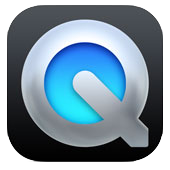MPEG-4 is group of international standards for the compression of digital audio and visual data, multimedia systems, and file storage formats. It was originally introduced in late 1998 as a group of audio and video coding formats and related technology agreed upon by the ISO/IEC Moving Picture Experts Group (MPEG) under the formal standard ISO/IEC 14496 – Coding of audio-visual objects. Uses of MPEG-4 include compression of audiovisual data for Internet video and CD distribution, voice and broadcast television applications. The MPEG-4 standard was developed by a group led by Touradj Ebrahimi and Fernando Pereira.

QuickTime is an extensible multimedia framework developed by Apple Inc., capable of handling various formats of digital video, picture, sound, panoramic images, and interactivity. Created in 1991, the latest Mac version, QuickTime X, is available for Mac OS X Snow Leopard up to macOS Mojave. Apple ceased support for the Windows version of QuickTime in 2016, and ceased support for QuickTime 7 on macOS in 2018.

Synchronized Multimedia Integration Language ) is a World Wide Web Consortium recommended Extensible Markup Language (XML) markup language to describe multimedia presentations. It defines markup for timing, layout, animations, visual transitions, and media embedding, among other things. SMIL allows presenting media items such as text, images, video, audio, links to other SMIL presentations, and files from multiple web servers. SMIL markup is written in XML, and has similarities to HTML.
Helix DNA is a project to produce computer software that can play audio and video media in various formats, aid in producing such media, and serve them over a network. It is intended as a largely free and open-source digital media framework that runs on numerous operating systems and processors and was started by RealNetworks which contributed much of the code. The Helix Community is an open collaborative effort to develop and extend the Helix DNA platform.
The MPEG-21 standard, from the Moving Picture Experts Group, aims at defining an open framework for multimedia applications. MPEG-21 is ratified in the standards ISO/IEC 21000 - Multimedia framework (MPEG-21).
Advanced Audio Coding (AAC) is an audio coding standard for lossy digital audio compression. Designed to be the successor of the MP3 format, AAC generally achieves higher sound quality than MP3 encoders at the same bit rate.
Windows Media Video (WMV) is a series of video codecs and their corresponding video coding formats developed by Microsoft. It is part of the Windows Media framework. WMV consists of three distinct codecs: The original video compression technology known as WMV, was originally designed for Internet streaming applications, as a competitor to RealVideo. The other compression technologies, WMV Screen and WMV Image, cater for specialized content. After standardization by the Society of Motion Picture and Television Engineers (SMPTE), WMV version 9 was adapted for physical-delivery formats such as HD DVD and Blu-ray Disc and became known as VC-1. Microsoft also developed a digital container format called Advanced Systems Format to store video encoded by Windows Media Video.

VLC media player is a free and open-source, portable, cross-platform media player software and streaming media server developed by the VideoLAN project. VLC is available for desktop operating systems and mobile platforms, such as Android, iOS and iPadOS. VLC is also available on digital distribution platforms such as Apple's App Store, Google Play, and Microsoft Store.
Digital Living Network Alliance was founded by a group of PC and consumer electronics companies in June 2003 to develop and promote a set of interoperability guidelines for sharing digital media among multimedia devices under the auspices of a certification standard. DLNA certified devices include smartphones, tablets, PCs, TV sets and storage servers.
A container format or metafile is a file format that allows multiple data streams to be embedded into a single file, usually along with metadata for identifying and further detailing those streams. Notable examples of container formats include archive files and formats used for multimedia playback. Among the earliest cross-platform container formats were Distinguished Encoding Rules and the 1985 Interchange File Format.
OMA DRM is a digital rights management (DRM) system invented by the Open Mobile Alliance, whose members represent mobile phone manufacturers, mobile system manufacturers, mobile phone network operators, and information technology companies. DRM provides a way for content creators to set enforced limits on the use and duplication of their content by customers. The system is implemented on many recent phones. To date, two versions of OMA DRM have been released: OMA DRM 1.0 and OMA DRM 2.0.
These tables compare features of multimedia container formats, most often used for storing or streaming digital video or digital audio content. To see which multimedia players support which container format, look at comparison of media players.

GPAC Project on Advanced Content is an implementation of the MPEG-4 Systems standard written in ANSI C. GPAC provides tools for media playback, vector graphics and 3D rendering, MPEG-4 authoring and distribution.
General eXchange Format (GXF), is a file exchange format for the transfer of simple and compound clips between television program storage systems. It is a container format that can contain Motion JPEG (M-JPEG), MPEG, or DV-based video compression standards, with associated audio, time code, and user data that may include user-defined metadata.
The HTML5 specification introduced the video element for the purpose of playing videos, partially replacing the object element. HTML5 video is intended by its creators to become the new standard way to show video on the web, instead of the previous de facto standard of using the proprietary Adobe Flash plugin, though early adoption was hampered by lack of agreement as to which video coding formats and audio coding formats should be supported in web browsers. As of 2020, HTML5 video is the only widely supported video playback technology in modern browsers, with the Flash plugin being phased out.
The Helix Universal Media Server was a product developed by RealNetworks and originates from the first streaming media server originally developed by Progressive Networks in 1994. It supported a variety of streaming media delivery transports including MPEG-DASH RTMP (flash), RTSP (standard), HTTP Live Streaming (HLS), Microsoft Silverlight and HTTP Progressive Download enabling mobile phone OS and PC OS media client delivery.
Unified Speech and Audio Coding (USAC) is an audio compression format and codec for both music and speech or any mix of speech and audio using very low bit rates between 12 and 64 kbit/s. It was developed by Moving Picture Experts Group (MPEG) and was published as an international standard ISO/IEC 23003-3 and also as an MPEG-4 Audio Object Type in ISO/IEC 14496-3:2009/Amd 3 in 2012.
Dynamic Adaptive Streaming over HTTP (DASH), also known as MPEG-DASH, is an adaptive bitrate streaming technique that enables high quality streaming of media content over the Internet delivered from conventional HTTP web servers. Similar to Apple's HTTP Live Streaming (HLS) solution, MPEG-DASH works by breaking the content into a sequence of small segments, which are served over HTTP. An early HTTP web server based streaming system called SProxy was developed and deployed in the Hewlett Packard Laboratories in 2006. It showed how to use HTTP range requests to break the content into small segments. SProxy shows the effectiveness of segment based streaming, gaining best Internet penetration due to the wide deployment of firewalls, and reducing the unnecessary traffic transmission if a user chooses to terminate the streaming session earlier before reaching the end. Each segment contains a short interval of playback time of content that is potentially many hours in duration, such as a movie or the live broadcast of a sport event. The content is made available at a variety of different bit rates, i.e., alternative segments encoded at different bit rates covering aligned short intervals of playback time. While the content is being played back by an MPEG-DASH client, the client uses a bit rate adaptation (ABR) algorithm to automatically select the segment with the highest bit rate possible that can be downloaded in time for playback without causing stalls or re-buffering events in the playback. The current MPEG-DASH reference client dash.js offers both buffer-based (BOLA) and hybrid (DYNAMIC) bit rate adaptation algorithms. Thus, an MPEG-DASH client can seamlessly adapt to changing network conditions and provide high quality playback with few stalls or re-buffering events.

CineAsset is a complete mastering software suite by Doremi Labs that can create and playback encrypted and unencrypted DCI compliant packages from virtually any source. CineAsset includes a separate "Editor" application for generating Digital Cinema Packages (DCPs). CineAsset Pro adds the ability to generate encrypted DCPs and Key Delivery Messages (KDMs) for any encrypted content in the database.
Bitmovin is a multimedia technology company which provides services that transcode digital video and audio to streaming formats using cloud computing, and streaming media players. Founded in 2013, the Austrian company contributes to MPEG-DASH, an open standard that allows streaming video to be played in HTML5 video and Flash players.



